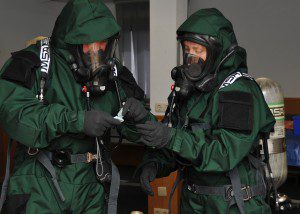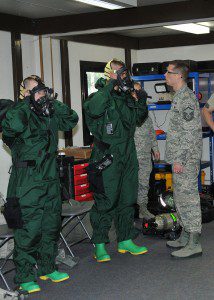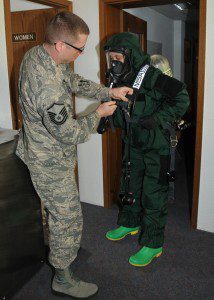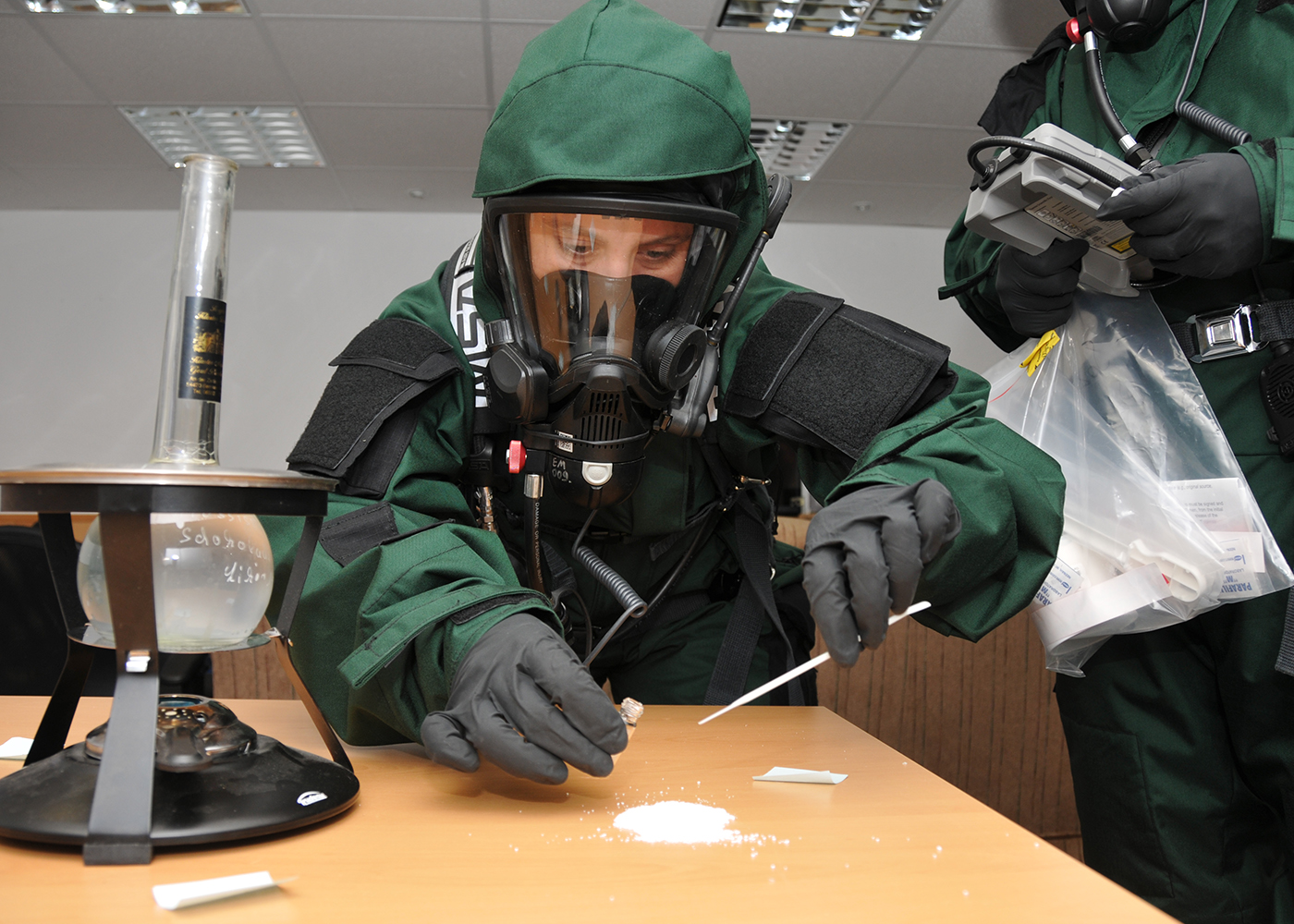
Technical Sgt. Nicole Locke, 104th Emergency Management Flight, Barnes Air National Guard Base, and active-duty Master Sgt. Tony Malbrough, sample an unknown substance for testing during an exercise May 6 at Spangdahlem Air Base, Germany. Locke is training on Active CBRNE (Chemical Biological Radiological Nuclear and High- Yield Explosives) Response with the active-duty members to enhance their Hazmat Technician Certification. This is a required training that needs to be done by the guard and the active duty. Doing the training together allows them to increase their knowledge by sharing their experiences and use different types of equipment. (U.S. Air National Guard photo by 2nd Lt. Bonnie Harper/Released)
by SECOND LIEUTENANT BONNIE HARPER
Public Affairs
Massachusetts Air National Guard
SPANGDAHLEM AIR BASE, Germany – Airmen from the Emergency Management Flight, 104th Civil Engineer Squadron at Barnes Air National Guard Base participated in an Active CBRNE (chemical, biological, radiological, nuclear, and high-yield explosives) Response exercise Wednesday at Spangdahlem Air Base in Germany.
The guardsmen worked alongside their active-duty counterparts during the ACR, training together and preparing to respond if needed in a real-world CBRNE incident.

Master Sgt. Christopher McCrary, Emergency Management Flight non-commissioned officer in charge, Barnes Air National Guard Base, , inspects Airman 1st Class Neal Colburn and active-duty Staff Sgt. John Gaylord in their Personal Protection Level-B suits during an exercise May 6 at Spangdahlem Air Base, Germany. The Guard and active-duty Airmen are training together on Active CBRNE (Chemical Biological Radiological Nuclear and High- Yield Explosives) Response to enhance their Hazmat Technician Certification. This is a required training that needs to be done by the guard and the active duty. Doing the training together allows them to increase their knowledge by sharing their experiences and use different types of equipment. (U.S. Air National Guard photo by Tech. Sgt. Melanie J. Casineau/Released)
“The Guard is well trained and just as capable of doing the same job that the active-duty does,” said Maj. Jeremy Dugan, 104th Civil Engineer Squadron commander.
Both guard and active-duty EM members were paired up and worked together in a three-phase exercise. First, they surveyed the room and cleared it for radiation; second, they took samples of any CBRNE evidence found in the simulated crime scene; and third, they established a recovery plan in order to clean and decontaminate the area, Dugan said.
“The ACR is required training that we’re supposed to do every single year,” said Master Sgt. Christopher McCrary, the 104th Emergency Management Flight non-commissioned officer in charge.
“We don’t always have the time to run something this in-depth on a guard drill weekend,” McCrary said. “Being able to do it in this type of environment is really great.”
The exercise involved a simulated contaminated dormitory, and EM was contacted to further investigate the scene before anyone else was allowed back, Dugan said.

Master Sgt. Christopher McCrary, Emergency Management Flight non-commissioned officer in charge, Barnes Air National Guard Base, inspects Airman 1st Class Neal Colburn and active-duty Staff Sgt. John Gaylord in their Personal Protection Level-B suits during an exercise May 6 at Spangdahlem Air Base, Germany. The Guard and active-duty Airmen are training together on Active CBRNE (Chemical Biological Radiological Nuclear and High- Yield Explosives) Response to enhance their Hazmat Technician Certification. This is a required training that needs to be done by the guard and the active duty. Doing the training together allows them to increase their knowledge by sharing their experiences and use different types of equipment. (U.S. Air National Guard photo by Tech. Sgt. Melanie J. Casineau/Released)
For any CBRNE exercise or incident, EM personnel determine what kind of equipment is necessary, the type of Personal Protective Equipment needed, and what could be potential threats, Dugan said.
Training with active-duty gives the guard the opportunity to see new equipment, get fresh ideas, new ways of thinking, which is hugely beneficial, McCrary said.
“When we work with them, we are able to build a confidence between active-duty and guard,” McCrary said. “They’re confident in our skills and abilities; we’re confident in their skills and abilities. So when we deploy together, we understand each other. We’re able to work together.
“The training is exactly the same across the board between active-duty and guard,” McCrary said. “A HAZMAT technician can go in and actually mitigate an event. We can go into the site and actually try to contain and actively engage in the incident.”
There are different levels of HAZMAT certification, but Emergency Management is the only career field in the Air Force in which Airmen come home from school with a technician certification.
“We’re not just ‘guardsmen,” Dugan said. “We’re valuable members of the total-force team. We provide the same capabilities.”
The EM guardsmen will continue to train at Spangdahlem throughout the week, providing them the opportunity to enhance their ability to respond in CBRNE and HAZMAT situations.


